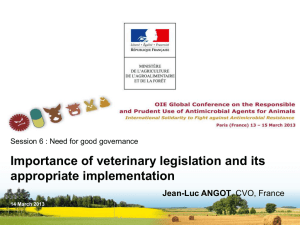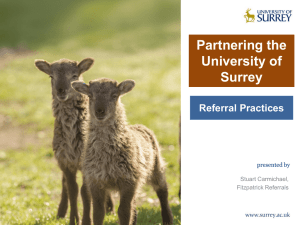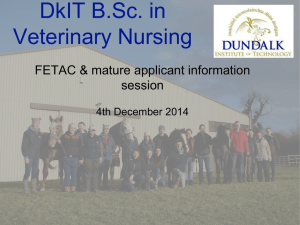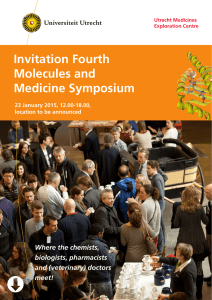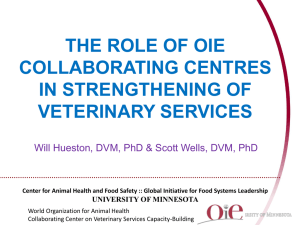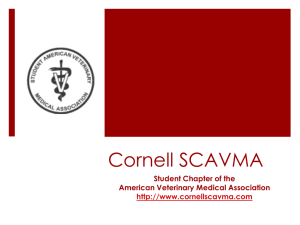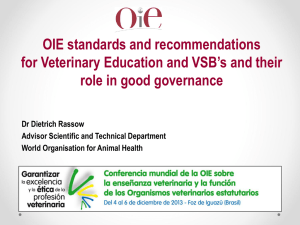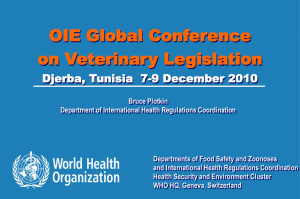CVM Update
advertisement
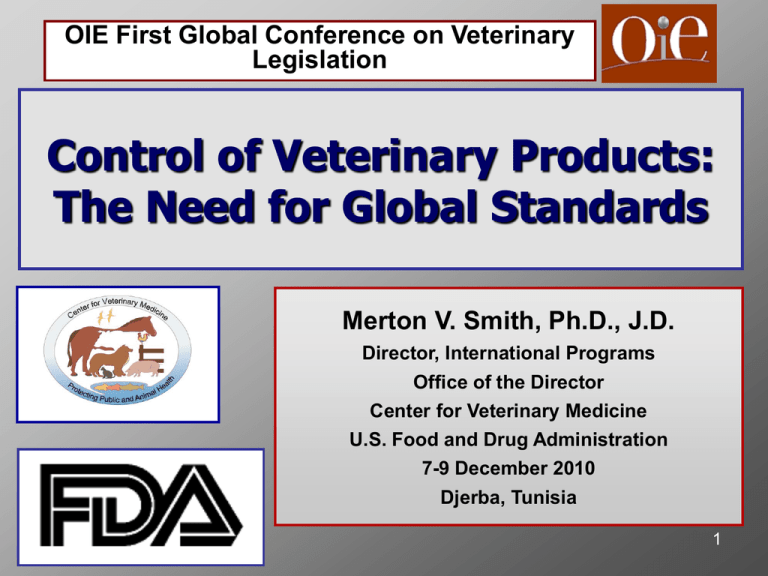
OIE First Global Conference on Veterinary Legislation Control of Veterinary Products: The Need for Global Standards Merton V. Smith, Ph.D., J.D. Director, International Programs Office of the Director Center for Veterinary Medicine U.S. Food and Drug Administration 7-9 December 2010 Djerba, Tunisia 1 “One World, One Health” Concept General Principles: – human-animal disease link – ecosystem interdependences, including effect of trade in animal products – need for holistic approaches to controls – adequate investment in global human and animal health infrastructure controls – need for intergovernmental collaborative relationships – assurance of adequate resources 2 Need for Harmonized International Standards for Veterinary Products • Veterinary medical products most often require pre-market approval • Many veterinary medical products are traded in international commerce • Foods and feeds (potentially containing drug residues) are traded in international commerce 3 Standards Relevant to Veterinary Products that Need to be Harmonized Internationally • Veterinary drug approval standards and procedures – including safety of drug residues in human food • • • • Antimicrobial resistance monitoring Pharmacovigilance procedures Safety standards for feed and feed ingredients Biotechnology assessment standards for veterinary medicines, food, and feed 4 Important International Veterinary Products Standard-Setting Venues in which FDA Participates • Multilateral • Bilateral – Codex Alimentarius – OIE – VICH – Canada (VDD and – CAMEVET – Quad countries – Trilateral forum – China (AQSIQ, SFDA, CFIA) – EU (EMA, DG SANCO, and EFSA) and MOA) – Others: India – Others: OECD, ISO, ASEAN 5 Major International Standards Harmonization Efforts WHO/FAO Codex Alimentarius Commission * International Cooperation on Harmonization of Technical Requirements for Registration of Veterinary Medicinal Products * World Organization for Animal Health 6 Codex Committee on Residues of Veterinary Drugs in Food (CCRVDF) • Recommends Maximum Residue Limits (MRLs) for veterinary drugs • Develops codes of practice related to the use of veterinary drugs in food-producing animals • Considers methods of sampling and analysis for the determination of drug residues in foods 7 Codex Task Force on Antimicrobial Resistance (TFAMR) • Develop guidance to assess human health risks associated with the presence in food and feed and the transmission through feed and food of antimicrobial resistant microbes and resistance genes • Develop guidance to allow countries or regions to implement risk management strategies based upon identified and prioritized needs and resources 8 Codex Task Force on Animal Feeding (TFAF) • Apply existing Codex risk assessment methodologies to hazards related to contaminants and residues in feed ingredients • Develop a prioritized list of feed ingredient hazards • Establish criteria for the global identification and notification of emergency situations affecting the feed sector and, ultimately, the food sector 9 World Organization for Animal Health • Terrestrial Animal Code – BSE – AMR • Aquatic Animal Code – Use of animal drugs in aquaculture • OIE Fifth Strategic Plan – Strengthening Veterinary Medicines Regulatory Infrastructures 10 International Cooperation on Harmonization of Technical Requirements for Registration of Veterinary Medicinal Products (VICH) 11 Goals of VICH • To establish harmonized technical requirements for registration or licensing of veterinary medicinal products (i.e., protocols and testing standards for studies required to show the safety, efficacy and quality of veterinary medicines) • Also includes post-approval reporting requirements for adverse drug events 12 Achievements • VICH officially began in April 1996 • It established – Structure (Steering Committee and Expert Working Groups) – Membership (regulatory and industry representatives from Japan, U.S., EU, Canada, Australia, and New Zealand; observers from OIE and IFAH) – Procedures – Work program 13 Developed Guidelines • Quality • Antimicrobial resistance • Safety • Good Clinical Practices • Anthelmintic efficacy • Target animal safety • Metabolism and residue • Ecotoxicity • Biologicals quality • Pharmaco/ vaccinovigilance kinetics • Microbiological ADI • Acute Rf Dose (under development) • Bioequivalence (under development) 14 VICH Global Outreach • VICH Global Outreach Working Group met in Washington, DC, on October 7-8, 2009, and in Paris on December 1-2, 2010 • OIE/VICH cooperation – 5th Strategic Plan of OIE – promotion of VICH standards • OIE National Focal Points for Veterinary Products meetings – Serbia, Colombia, South Africa 15 Benefits of Harmonizing International Veterinary Medicinal Product Standards • International venues for exchange of concerns and issues between industry, consumers, and regulators • Harmonized testing standards result in wider and faster availability of safe and effective veterinary medicinal products, foods, and feeds worldwide • Opportunity to update regional standards 16 Difficulties Involved in Achieving International Harmonization of Product Standards and Testing Protocols • Some argue that WTO rules and international standards may result in lower standards for safety and health • Others maintain that international harmonization and collaboration unnecessarily raise standards • Product regulation is both science-based and law-based – in many ways two very different and “incompatible” methodologies 17 Scientific Process versus Legal Process Science • Truth-seeking • Consensus building • Issues capable of objective description • Timeliness is unimportant Law • Decision-seeking • Adversarial • Issues are usually described in subjective or value-laden terms • Timeliness is very important 18 Differing Legal/Value Judgments that Affect the International Harmonization of Science-Based Product Standards and Testing Protocols • Proper role of the government versus the proper role of the private sector in safety regulation • Adequacy of resources available for public health and animal health protection • Proper balancing of animal health protection and human health protection 19 “Bridging the Gap” Objective Data Common Goals (science-based (safe and effective studies) medicines) Subjective Elements 20 “Bridging the Gap” • Attempts to deal with subjective elements that affect product standards, testing protocols, and conformity assessments include… – Codex’s “Other Legitimate Factors” – Use of Risk Analysis methodology • But many national laws and values reflect the essence of what constitutes each country’s identity • Importance of transparency and of making every effort to separate scientific “fact” and value judgments 21 Merci! Thank you! 22

